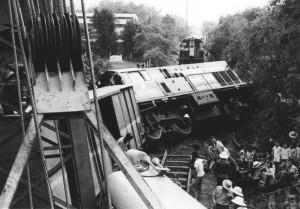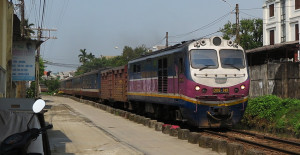
A “Rafale” armoured train pictured in south-central Việt Nam during the late 1940s, image from the archives of ECPAD (Etablissement de Communication et de Production Audiovisuelle de la Défense)
The Railways of Việt Nam is a new one-hour illustrated talk by Tim Doling, author of The Railways and Tramways of Việt Nam (White Lotus Press, 2012).
Illustrated by over 140 historic maps and images, this one-hour talk recounts the fascinating story of Việt Nam’s rail network, most of which was built as a tool of colonial exploitation by the French between 1885 and 1936.

One of the Saigon-Mỹ Tho line’s five SACM Belfort 4-4-0T “locomotives à grande vitesse” stands at Saigon Depot in the early 1900s
Its turbulent history mirrors that of Việt Nam through more than 90 years of colonialism, 30 years of devastating war and 40 years of reconstruction.
The first half of the talk traces the growth of the Vietnamese rail network, starting with the very first railway lines from Saigon to Mỹ Tho (1885) and from Phủ Lạng Thương (Bắc Giang) to Lạng Sơn (1894), and continuing through the construction of the Transindochinois (North-South line), which was opened in five successive stages between 1905 and 1936.
It examines French attempts to build lines of exploitation into southern China via Lào Cai and Đồng Đăng, and also looks at the abortive 1920s scheme for an “Interior rail route” through the Mekong valley, of which only the extraordinary rail-and-cable-car connection from Tân Ấp to Xóm Cục and Ban Na Phao (see The Railway which Became an Aerial Tramway) and the so-called “Rubber Line” from Saigon to Lộc Ninh (see Saigon’s Rubber Line) were actually achieved.

One of over 960 sabotage incidents on the South Vietnamese railway network in 1965
It also considers the repeated failure of the French to connect Phnom Penh with Saigon, the “missing link” which, when eventually completed, will link Singapore, Kuala Lumpur and Bangkok directly with Beijing, Moscow and Europe.
The second half of the talk examines the devastating effect on the railway network of more than three decades of war, beginning with Allied bombing during the later years of Japanese occupation (1943-1944), and continuing with the catastrophic damage inflicted during the First and Second Indochina Wars (1945-1975).
The talk assesses the impact of war on the rail network both in the North (Democratic Republic of Việt Nam) and in the South (Republic of Việt Nam).
It brings the story up to date by looking at the gradual reconstruction and development of the rail network which took place after 1975.
 The talk concludes with a brief overview of recent plans to develop a modern twin-track electrified standard gauge railway, linked not just to China but also to Laos, Cambodia, Malaysia and Thailand.
The talk concludes with a brief overview of recent plans to develop a modern twin-track electrified standard gauge railway, linked not just to China but also to Laos, Cambodia, Malaysia and Thailand.
For more details please email tim.doling@historicvietnam.com.
Tim Doling is the author of The Railways and Tramways of Việt Nam (White Lotus Press, Bangkok, 2012) and also conducts 16-day and 13-day Việt Nam Rail Tours.
A full index of all Tim’s blog articles since November 2013 is now available here.
Join the Facebook group Rail Thing – Railways and Tramways of Việt Nam for more information about Việt Nam’s railway and tramway history and all the latest news from Vietnam Railways.

